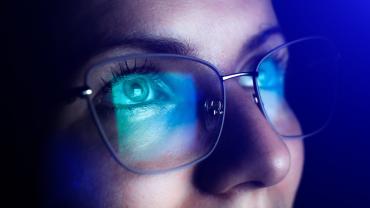
Manufactured light sources such as mobile devices, LED lights, computers, and other screens emit light in the blue range of the visible spectrum. Prolonged exposure to blue light may be potentially damaging to the eye due to changes caused by oxidative stress and the potential induction of an inflammatory response. Evidence also suggests that blue light overexposure may induce a significant increase in reactive oxygen species (ROS) production, possibly contributing to lipid peroxidation, damage to DNA, and other potentially harmful changes to cellular health. Other eye-related pathologies have also been correlated in literature with increases in oxidative stress and age-related changes. A recently published review article by Rodella and colleagues explored the potential role of certain micronutrients to support antioxidative status and eye health.
The eye contains a complex system of molecules and enzymes to help support antioxidative pathways. Glutathione (GSH), the body’s ‘powerhouse’ antioxidant, is one of the most abundant ROS-scavenging molecules in the eye. Zinc is a trace mineral that helps promote GSH and superoxide dismutase production and helps protect sulfhydryl groups from oxidation. Recent evidence suggests that zinc supplementation may help support certain aspects of eye health. A clinical trial involving supplementation with vitamin C, zinc, beta-carotene, and vitamin E was reported to help support visual acuity and significantly reduce the risk of certain age-related eye changes. While it is difficult to make specific conclusions because several micronutrients were used in combination, evidence suggests that further research regarding zinc’s potential for supporting ophthalmic health is warranted.
α-lipoic acid (ALA) is a molecule found in fruits and vegetables such as spinach, broccoli, and tomatoes and acts as a cofactor for some enzymatic reactions related to cellular energy production. While it is well-known for its supportive role in glucose metabolism, it may also help support the inflammatory response and help modulate the activity of certain pro-inflammatory cytokines including nuclear factor-κB (NF-κB). It may also help restore endogenous antioxidant levels of GSH and scavenge ROS. Research indicates that ALA reaches the optic nerve and retina relatively quickly upon ingestion. Animal studies have observed improvements in parameters related to oxidative stress and inflammation in the retina in the presence of ALA.
Riboflavin (vitamin B2) may also help support eye health. It has been shown in animal studies to help support normal cellular function, help protect the retina from oxidative damage, and help increase brain-derived neurotrophic factor (BDNF) levels. Riboflavin administration has been associated with the production of GSH and SOD in certain eye compartments. It may also help absorb UV light; an animal study reported a protective quality against UVB light in the presence of an eyedrop formula containing riboflavin.
Polyphenols such as flavonoids and anthocyanins are plant-derived micronutrients that may also help promote healthy eye integrity and antioxidative status. Resveratrol has been shown to scavenge ROS, help support the expression of enzymes related to antioxidative pathways, and promote a normal inflammatory response. A laboratory study reported improvements in the expression of glaucoma-related markers such as endothelial-leukocyte adhesion molecule 1 (ELAM-1), interleukin (IL)-1a, IL-6, and IL-8, alongside improvements in cellular senescence markers such as sa-β-galactosidase in the presence of resveratrol.
While more research is needed, evidence suggests that certain micronutrients may support optimal eye health, age-related changes, and antioxidative status.
By Dr. C. Ambrose, ND, MAT